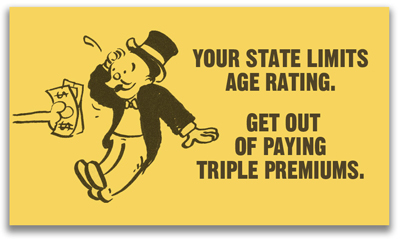

The Affordable Care Act leaves it to the states to decide whether they will allow insurers to charge older Americans more for coverage. If a state takes no action, a 64-year-old buying his own health insurance in the individual market will pay up to three times more than an 18-year-old.
The Affordable Care Act leaves it to the states to decide whether they want to let insurers charge older Americans more for coverage. If a state takes no action, a 64-year-old buying his own insurance in the individual market will pay up to three times more than an 18-year-old. In the small-group market – if a small business employs an unusually large number of older workers – the same 3:1 ratio applies.
Today, in most states, there are no caps on how much insurers can charge a 60-something forced to purchase his own insurance. In the individual market, only New York State bans age rating altogether, and just three other states limit how much premiums can vary, based on age, to less than 3:1. When insurers sell policies to small businesses, Vermont also prohibits age rating, but only five other states cap increases.
To check whether your state shields older boomers in either of these markets, take a look at these charts. (A checkmark in the right-hand column means that age rating is now unregulated in that state.)
Help from the younger generation?
Under reform, more states could decide to ban age rating, or follow Massachusetts' example, and limit the ratio to 2:1. But, politically, this would be a third-rail decision.
If older boomers pay less, younger adults would be charged more, and most are vehemently opposed to being asked to support the Pepsi Generation. As one of my younger readers once commented, "I'm willing to help my mother, but not someone else's mother."
Just how much more would a 20-something pay? According to researchers at the Urban Institute, eliminating age rating would lift average premiums for those 18 to 34 years old by $1,400 (from $3,600 to $5,000). Policy holders ages 35 to 44 would see their premiums rise by $800 (from $4,200 to $5,000). Meanwhile, premiums for those between age 45 and 64 would fall by about $2,400, from $7,500 to $5,100.
In other words, when costs are distributed over a large group, older adults save more than younger adults lose.
Still, many believe that older Boomers can and should pick up the higher tab for their own care. After all, throughout their financial lives, they have been luckier than most: they enjoyed first crack at the employment market when jobs were plentiful, and first dibs on housing when homes were affordable.
A generation hit hard
Yet in recent years, the economy has not been kind to the rock 'n roll generation. One in six is now unemployed, and from 2000 to 2011, the average (mean) after-tax income of Americans age 45 to 54 (who are now in their 50s and early 60s) plunged by 13.3 percent.
By that measure, the recession has hit them harder than other age groups except Americans aged 15 to 24. Over those years, this cohort should have been enjoying their peak earning years. But they didn't.
Even worse, the Wall Street Journal reports, "at an age when they should be generating peak ... savings," many have been raiding their retirement funds and "applying for early Social Security benefits." Among median-income households headed by someone age 55 to 64, total savings and assets stand at just $87,200. In 2014, they will be the 50- to 64-year-olds struggling to scrape together $7,500 to $8,500 to purchase health insurance in the individual market.
Of course, younger middle-class Americans also have watched their incomes slide, but time is on their side. They have many more years to recover. The problem for a jobless 60-year-old is that she won't be able to make up for her losses unless she finds a higher-paying job – and that isn't likely.
In 2014, just how many older Americans will find that they can't afford universal coverage? Writing in Health Affairs in February, the Urban Institute's researchers estimated that under reform, age rating means that roughly 1 million Americans age 45 to 64 will forego insurance.
Abolish age rating?
Yet there's a trade off: if age rating were abolished, younger adults would be charged more, and some would decide they can't afford insurance. Bottom line: "the number of uninsured older Americans would be roughly offset by increases in the number of uninsured adults in the two younger age groups (18-34 and 34-44)."
This worries policymakers for two reasons. First, we need young, healthy Americans in the pool to keep insurance costs down. Secondly, if young families decide to forego insurance, many won't buy separate policies for the children.
How do we choose between children and their grandparents?
If we don't want to ration care, the only rational solution is to bring down the cost by trimming waste in our health care system. This will be difficult. Most of the fat isn't hanging out on the edges of the steak – it's marbled throughout in the form of unnecessary treatments and over-priced products. It needs to be removed carefully, with a scalpel. But it can be done.
Maggie Mahar is an author and financial journalist who has written extensively about the American health care system. Her book, Money-Driven Medicine: The Real Reason Health Care Costs So Much, was the inspiration for the documentary, Money Driven Medicine. She is a prolific blogger, writing most recently for TIME's Moneyland. Previously she wrote and edited the Health Beat blog for the progressive think tank, The Century Foundation. She also recently provided background on Congressional health care legislation for HealthReformVotes.org, a special project of the Health Insurance Resource Center.


